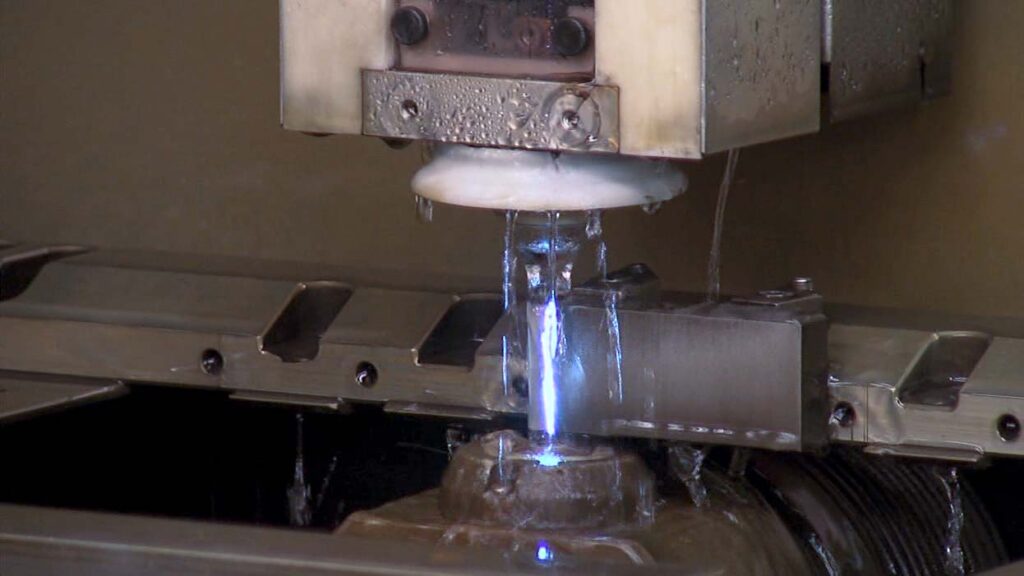Have you ever wondered how to cut aluminum more affordably using wire EDM machining? It’s a cost-effective method for shaping conductive metals. But for aluminum wire EDM, the high material wear, fluid costs, and other factors can add up expenses over time.
To reduce wire EDM aluminum cost, you have to focus on some specific aspects, including optimizing processing parameters, maintaining your equipment, and making strategic material choices. This can significantly lower wear on the wire and improve efficiency, ultimately saving you money without sacrificing quality.
We’ll discuss all the factors that can help cut down the cost of wire EDM aluminum machining. With some adjustments to the machining process and taking preventative measures, you can significantly decrease the expenses long-term.
Wire EDM Aluminum Cost Factors and Solutions
Several cost factors come into play when doing precision EDM of aluminum. The metal is known for its great conductivity, but its softness can make machining tricky. This can lead to challenges, like gummy build-up, which may increase expenses.
Understanding these wire EDM aluminum cost factors is important for anyone looking to get the best results without breaking the bank. Let’s find out what they are and their practical solutions.
1. Material Waste for Cutting Parameters
Material waste is a real problem in driving up wire EDM metal cutting costs in general, including aluminum. It arises from various incorrectly set cutting parameters, leading to inefficient machining processes.
Common culprits include improper voltage settings and incorrect pulse durations. These missteps can cause the machine to use more material than necessary.
Every time a wire EDM machine cuts, it removes a certain amount of material, known as the kerf. A wider kerf means more aluminum is wasted. If the parameters are not optimized, the machine can end up cutting away too much material. This not only increases waste but also affects the quality of the final product. The precision of the cut and the surface finish can suffer, leading to additional finishing work that adds to overall costs.
Solution
To tackle material waste, you need to focus on optimizing cutting parameters. This involves adjusting settings, like pulse duration, voltage, and current. Fine-tuning these aspects can improve the material removal rate without unnecessarily wearing out the electrode wire or consuming excess energy.
For instance, adjusting the voltage can help control how much material is removed during each pulse. If the voltage is set too high, it can create a wider kerf, leading to more waste. On the other hand, if it’s too low, the cutting process may become inefficient, requiring longer machining times.
2. Small Pulse Interval
In wire EDM, the process involves sending electrical pulses through a wire to create precise cuts in materials, such as aluminum. If the pulse interval is too small, it can lead to the formation of larger particles during machining. These particles, often made of alumina (aluminum oxide), can cling to the molybdenum wire used for cutting. When these particles attach to the wire, they interfere with the cutting process, making it less efficient.
These particles affect the electrical conductivity of the wire. A decrease in conductivity can result in uneven cutting and increased wear on the wire. This means that you might need to replace the wire more often, which can drive up costs. Also, if the cutting isn’t precise, it may lead to more material being wasted or the need for rework, further increasing expenses.
Solution
To tackle the issue of small pulse intervals, it’s important to find a balance in the pulse electrical parameters. One effective solution is to adjust the no-load voltage amplitude of the pulse power supply. By increasing this voltage, you can enhance the cutting process.
Moreover, reducing the pulse width and the processing pulse gap can help minimize the chances of debris attaching to the wire. This adjustment allows for a cleaner cut and reduces the likelihood of larger particles forming. As a result, the wire remains more efficient and effective, prolonging its lifespan and reducing material waste.
3. Wrong Wire Type
Using the wrong wire can lead to less efficient cutting and increased wire EDM aluminum cost. It’s not just about making a cut; it’s about making the right cut. Different wire materials, like brass, copper, and molybdenum, have unique properties. These properties affect how well they conduct electricity and resist wear.
For aluminum specifically, using the correct wire can make a big difference. For instance, a special brass wire designed for cutting aluminum parts is often 0.20-mm in diameter. The wire is specially made to handle the specific challenges of aluminum, which can be softer and more prone to deformation than other metals. An incompatible wire can cause issues, like poor precision and increased wear on the wire itself.
Solution
You have to assess the material of your workpiece and the goals of your project. Understanding these factors will help you choose a wire type that aligns perfectly with your needs.
Invest in high-quality electrode wire, like coated brass. This wire lasts longer and offers better performance than regular brass wire. It can save you money in the long run by reducing the frequency of wire changes and improving cutting efficiency.
4. Neglecting Wire Maintenance
The wire used in EDM needs to withstand a lot of stress during the cutting process. If not maintained properly, it can break more frequently. This means more time spent replacing the wire, which can halt production and increase costs.
Another important factor is the flushing conditions. Flushing helps remove debris and keeps the wire cool. Not flushing regularly causes particle buildup, leading to wire damage and reduced performance.
The dielectric fluid is another factor. This fluid cools the wire and helps improve its longevity. If it’s subpar or not changed regularly, it can lead to wear and tear on the wire.
Solution
So, what can be done to address these maintenance issues? Regular inspections are key. Checking the wire for signs of wear and ensuring that flushing systems are working correctly can prevent problems before they start. Setting a routine for changing dielectric fluid and ensuring it meets quality standards will also help maintain wire integrity.
5. Incorrect Machine Settings
Incorrect machine settings can increase the cost of wire EDM aluminum. It can lead to wasted materials, longer production times, and even damaged tools.
An uncalibrated EDM machine can either slow down or quicken the cutting speed. If it’s too slow, the machine will take longer to complete each job, which increases labor costs. Conversely, if it’s too fast, the wire might break, leading to downtime and additional material costs.
Another problem can arise from incorrect feed rates. If the feed rate is not set right, it can cause poor surface finishes or even part defects. This means parts may need to be reworked or scrapped, which adds even more to the cost.
Solution
To counteract these issues, regular machine maintenance is crucial. You must check and adjust machine settings before starting a new job. It’s also helpful to keep a record of successful settings for different projects. This way, you can quickly refer to them in the future, saving time and reducing errors.
Using multi-cutting strategies can also be effective. This approach allows the machine to take fewer passes to achieve the desired depth. Optimizing the cutting process reduces wire wear and saves time. Less wear means fewer replacements, which lowers costs.
Efficient tool path programming is another key aspect. By minimizing unnecessary movements, you can significantly speed up the process. A well-planned tool path ensures that the machine operates smoothly and accurately, leading to better results with less waste.
6. Irregular Machine Maintenance
When you’re crafting precision machining parts, you must maintain the EDM machine on a regular basis. Otherwise, it can lead to many issues that will slow down the production, resulting in more expenses.
Solution
You must keep your wire EDM machine under regular monitoring and maintenance. Keeping it calibrated ensures it operates at its best. Regular checks help catch any issues before they become bigger problems.
Also, regularly cleaning and lubricating machine parts keeps everything running smoothly. This kind of upkeep prevents wear and tear, ensuring that machines stay operational for longer periods.
When you’re taking wire machining service from a shop, don’t forget to review whether they use the best practices to keep the cost down.
Conclusion
Reducing wire EDM aluminum cost requires a multi-faceted approach. By optimizing cutting parameters, maintaining your equipment, and making strategic material choices, you can significantly lower expenses without sacrificing quality. With these strategies, you can have cost-effective wire EDM machining.
Ready to cut costs on your custom precision parts? At Zintilon, we specialize in efficient machining solutions, including wire EDM. Let us help you optimize your production and save money with our wire EDM machining services.
——————————————–


